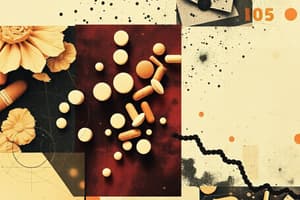Podcast
Questions and Answers
Which mechanism of drug absorption involves the drug binding to a cell membrane and being engulfed?
Which mechanism of drug absorption involves the drug binding to a cell membrane and being engulfed?
- Facilitated diffusion
- Active transport
- Passive diffusion
- Endocytosis (correct)
Which factor negatively affects the absorption of local anesthetics when co-administered?
Which factor negatively affects the absorption of local anesthetics when co-administered?
- Coadministration of vitamin B12
- Coadministration of adrenaline (correct)
- Coadministration of ferrous iron
- Coadministration of calcium
What happens to weak acids when placed in an alkaline solution?
What happens to weak acids when placed in an alkaline solution?
- They become unchanged
- They become more lipid-soluble
- They become more water-soluble
- They become more ionized (correct)
What can be inferred about a drug with high lipid solubility in terms of absorption?
What can be inferred about a drug with high lipid solubility in terms of absorption?
What does the term bioavailability refer to?
What does the term bioavailability refer to?
Which route of drug administration guarantees 100% bioavailability?
Which route of drug administration guarantees 100% bioavailability?
What is the 'first pass effect' in pharmacology?
What is the 'first pass effect' in pharmacology?
Which drug is significantly affected by the hepatic first pass effect?
Which drug is significantly affected by the hepatic first pass effect?
What is the primary focus of pharmacokinetics?
What is the primary focus of pharmacokinetics?
Which route of drug administration has the fastest absorption rate?
Which route of drug administration has the fastest absorption rate?
Which factor increases drug absorption?
Which factor increases drug absorption?
What role does metabolism play in pharmacokinetics?
What role does metabolism play in pharmacokinetics?
What is the effect of calcium on the absorption of tetracyclines?
What is the effect of calcium on the absorption of tetracyclines?
What is the term for the pH at which drug ionization is equal to its unionized form?
What is the term for the pH at which drug ionization is equal to its unionized form?
Which type of transport involves the movement of substances from high to low concentration without energy?
Which type of transport involves the movement of substances from high to low concentration without energy?
Which factor related to patients affects drug absorption?
Which factor related to patients affects drug absorption?
What is the primary function of biotransformation in pharmacology?
What is the primary function of biotransformation in pharmacology?
Which process can shorten the effective duration of a drug in the body?
Which process can shorten the effective duration of a drug in the body?
Which factor primarily influences the extent of drug distribution in the body?
Which factor primarily influences the extent of drug distribution in the body?
What is a significant consequence of a drug having a long elimination half-life?
What is a significant consequence of a drug having a long elimination half-life?
What occurs to a prodrug in the body during metabolism?
What occurs to a prodrug in the body during metabolism?
How does inflammation affect the permeability of the blood-brain barrier?
How does inflammation affect the permeability of the blood-brain barrier?
Which drug is associated with significant teratogenic effects when it crosses the placental barrier?
Which drug is associated with significant teratogenic effects when it crosses the placental barrier?
What is the result of enzyme inhibition on a drug's pharmacological actions?
What is the result of enzyme inhibition on a drug's pharmacological actions?
Flashcards
Pharmacokinetics
Pharmacokinetics
The study of how drugs are absorbed, distributed, metabolized, and excreted in the body.
Drug Absorption
Drug Absorption
The process by which a drug moves from the site of administration into the bloodstream.
Passive Diffusion
Passive Diffusion
Drug movement across membranes from a higher concentration to a lower concentration, without energy.
Active Transport
Active Transport
Signup and view all the flashcards
Intravenous Administration
Intravenous Administration
Signup and view all the flashcards
Drug Metabolism
Drug Metabolism
Signup and view all the flashcards
Drug Excretion
Drug Excretion
Signup and view all the flashcards
Lipid Solubility
Lipid Solubility
Signup and view all the flashcards
Ionization
Ionization
Signup and view all the flashcards
pKa
pKa
Signup and view all the flashcards
Route of administration
Route of administration
Signup and view all the flashcards
Active Transport
Active Transport
Signup and view all the flashcards
Facilitated Diffusion
Facilitated Diffusion
Signup and view all the flashcards
Passive Diffusion
Passive Diffusion
Signup and view all the flashcards
Endocytosis
Endocytosis
Signup and view all the flashcards
Oral Drug Administration (in shock)
Oral Drug Administration (in shock)
Signup and view all the flashcards
Weak Acids in Alkaline Solution
Weak Acids in Alkaline Solution
Signup and view all the flashcards
Drug Absorption Mechanism: Endocytosis
Drug Absorption Mechanism: Endocytosis
Signup and view all the flashcards
Co-administration of Adrenaline (and local anesthetics)
Co-administration of Adrenaline (and local anesthetics)
Signup and view all the flashcards
Most Efficient Drug Form
Most Efficient Drug Form
Signup and view all the flashcards
High Lipid Solubility
High Lipid Solubility
Signup and view all the flashcards
Higher pKa Value (Weak Acid)
Higher pKa Value (Weak Acid)
Signup and view all the flashcards
Lipid Soluble Drug Absorption
Lipid Soluble Drug Absorption
Signup and view all the flashcards
Bioavailability
Bioavailability
Signup and view all the flashcards
100% Bioavailability Route
100% Bioavailability Route
Signup and view all the flashcards
Hepatic First-Pass Effect
Hepatic First-Pass Effect
Signup and view all the flashcards
Inactive drug form
Inactive drug form
Signup and view all the flashcards
Toxic metabolite
Toxic metabolite
Signup and view all the flashcards
Plasma protein binding
Plasma protein binding
Signup and view all the flashcards
Drug distribution
Drug distribution
Signup and view all the flashcards
Liver drug metabolism
Liver drug metabolism
Signup and view all the flashcards
Enzyme induction
Enzyme induction
Signup and view all the flashcards
Drug excretion (primary site)
Drug excretion (primary site)
Signup and view all the flashcards
Elimination half-life (t1/2)
Elimination half-life (t1/2)
Signup and view all the flashcards
Free drug
Free drug
Signup and view all the flashcards
Biotransformation
Biotransformation
Signup and view all the flashcards
Blood-brain barrier
Blood-brain barrier
Signup and view all the flashcards
Teratogenicity
Teratogenicity
Signup and view all the flashcards
Enzyme inhibition
Enzyme inhibition
Signup and view all the flashcards
Drug absorption (primary site)
Drug absorption (primary site)
Signup and view all the flashcards
First-pass metabolism
First-pass metabolism
Signup and view all the flashcards
Prodrug
Prodrug
Signup and view all the flashcards
Inflammation effect on BBB
Inflammation effect on BBB
Signup and view all the flashcards
Study Notes
Pharmacokinetics MCQ
- Pharmacokinetics: Focuses on drug absorption, distribution, metabolism, and excretion.
- Drug absorption: Passage of a drug from the site of administration to systemic circulation.
- Primary mechanism: Passive diffusion; active transport also exists.
- Factors affecting Absorption:
- Lipid solubility: High is better
- Ionization: Low pH for weak acids, high pH for weak bases improves absorption
- Drug solubility
- Route of administration (Oral, IV, etc).
- Factors influencing drug metabolism:
- Enzyme induction/inhibition
- Co-administration of other drugs
- Factors related to patients:
- Ionization
- Route of administration
- Hepatic first-pass effect: Metabolism of a drug by the liver before reaching systemic circulation. Propranolol is affected by the hepatic first-pass effect.
- Bioavailability: Percentage of a drug reaching systemic circulation unchanged. IV has 100%. Oral is affected by first pass.
- Biotransformation: (Metabolism): Converting drugs into water-soluble metabolites
- Importance: Increased drug excretion, reduced toxicity, alteration of pharmacological effects
- Drug binding to plasma proteins: In inactive form, affects distribution.
- Blood-brain barrier: Prevents certain drugs from entering the brain.
- Placental barrier: Certain drugs can cross and cause teratogenicity (birth defects).
- Enzyme induction: Increased metabolism of drugs, and reduced drug efficacy/half-life. Increased absorption rate.
- Enzyme inhibition: Decreased metabolism of drugs and increased drug toxicity
- Major sites for drug metabolism: Liver.
- Primary sites for drug excretion: Kidneys
- Elimination half-life (t1/2): Time for half the drug to be eliminated.
- First-pass effect: Reduction in drug bioavailability due to initial metabolism in the liver.
General Pharmacology MCQ (Specific Questions)
- Primary focus of pharmacokinetics: Drug absorption, distribution, metabolism, and excretion.
- Drug absorption: Absorption across biological membranes is primarily via passive diffusion.
- Absorption process: Drug movement across membrane from site of administration to systemic circulation.
- Main drug absorption mechanism (biological membranes): Passive diffusion
- Energy requirement for drug movement: Active transport requires energy (e.g. endocytosis).
- Fastest absorption route: Intravenous.
- Factors that increase drug absorption: High lipid solubility, low pH for weak acids, and high for weak bases.
- Role of metabolism: Breakdown drugs into metabolites.
- Effect of calcium on tetracycline absorption: Decreases absorption.
- pKa: pH at which ionization of a drug is equal to its unionized form.
- Factors affecting drug absorption: Systemic circulation, vascularity, and nature of the compound.
- Transport types:
- Passive diffusion (no energy)
- Active transport (energy required for movement)
- Facilitated diffusion (no energy, facilitated by a carrier).
- Least suitable route during shock: Oral.
- Weak acids in alkaline solutions: Become more ionized.
- Drug absorption mechanism (envelopment): Endocytosis
- Local anesthetic absorption decrease: Co-administration.
- Efficient drug form (absorption): Solution.
- High lipid solubility effect: Increased absorption.
- Effect of higher pKa on weak acid: Weaker acid.
Studying That Suits You
Use AI to generate personalized quizzes and flashcards to suit your learning preferences.




